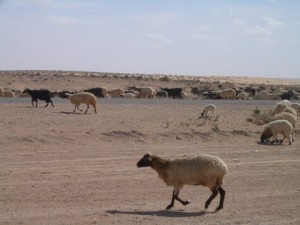 A short time ago, I heard a nice program on Bayern2 on sheep. Among other things, I learned that, regardless of intense domestication (Domestizierung), they are still very sensitive and cognitively strong creatures.
A short time ago, I heard a nice program on Bayern2 on sheep. Among other things, I learned that, regardless of intense domestication (Domestizierung), they are still very sensitive and cognitively strong creatures.
The light colour of their fur is a result of their domestication. Light wool is easier to process and dye than dark wool. In general, domestication leads to a lightening of the skin or fur in animals. I also learned about “black sheep”. Once in a while, the original sheep is still prevalent. Then we get a black sheep. Their life is not easy.
In Germany, most sheep have very light fur colour, whereas in Africa, they still have to have a black spot on their fleece. It is necessary for the production of a substance that protects them against the sun’s rays. All-white sheep die young in Africa …
The above photo of sheep has been taken during my bike-tour through Tunesia. All sheep on the picture have a black spot. Incidentally, a pickup truck full of labourers drove into the herd of sheep shortly after I took the picture.
In the aforementioned program, I also learned the origins of the German “Schäferstündchen” (literally „shepherd’s hour”). For many centuries, there was an infection transported from sheep to man that made men sterile. That is why shepherds were mostly sterilized and therefore favoured lovers. After all, there were usually no undesired pregnancies after a love-affair with a shepherd.
Incidentally, shepherds had a special role in society (like witches). They were used for special purposes, for example as “knacker”. They also had the reputation of being knowledgeable about herbs and healing. Many people feared them because they thought them evil wizards.
There is a similar story about cows and milkmaids. Cows transported a chickenpox species that was harmless for humans. If you had been infected once, you were immunized against the hard chickenpox. That is how milkmaids often retained their pure facial skin and were therefore rather on demand on the marriage market. After all, the competition often consisted of by quite a few pockmarked girls. That is also how the vaccination serum against chickenpox was developed.
Of course, this kind of story makes me immediately think of our “swine infection”.
Last week, there was again plenty of uproar among the German newspapers and in German politics. Health insurances want to increase the contribution rate because of the cost of the coming mass vaccination. What is interesting for me is that word of the “coming mass vaccination” has only reached the public through the argument about the cost.
As I see it, there is no difference between the health insurances or the state paying. In the end, it is always our involuntary contribution that pays for such a vaccination, no matter if you call them taxes or health insurance premiums.
What is much more interesting for me is the “mass vaccination” as such. I wonder if it is necessary under the circumstances. It is an interesting question whether the current threat should be met by such a step. The decision should certainly be based on a responsible weighing of interests.
And there are quite a few questions that must be asked:
Will there be moral pressure on people to go and get the vaccination? Will there be a compulsory vaccination, maybe with sanctioning if you do not get it? Should people then get two vaccinations, one against common flu and one against swine infection? Or is the vaccination against swine infection maybe totally unnecessary, only motivated by over-the-top safety concepts?
The example of vaccination against smallpox shows how much sense a compulsory vaccination can make. This infection has a mortality rate between 10 % and 90 %. But it is certainly possible to vaccinate too early and too much. That is why the decision about compulsory or mass vaccination must be thoroughly pondered.
I doubt if that has been done about the question concerning vaccination against swine infection. Not long ago, it was the bird infection everybody considered our main threat. Tomorrow, the next threat might originate with the sheep. Just imagine a world-wide sterilization threat. Or else, imagine the smallpox virus getting out of a laboratory, be it for civilian or military purposes. Then we can talk about having a real problem.
And if you are a cynic, you might remind people that, since they are so scared of maladies and death, there are quite a few maladies around the world that badly need fighting against. How many people still die every day on our streets? How many die because of obesity caused by wrong eating habits and too little physical activity or from smoking cigarettes?
How many people starve or die from drinking polluted water every day? How many women die after childbirth or mutilation? How many people die in wars (or war-like conflicts)? Or simply: how many people get a serious infection of the throat because they have been sitting in an air-conditioned car, hotel or office?
However, I really and honestly admire the lobby work done by the pharmaceutical industry! After Tamiflu, it now successfully promoted the next product. And on a world-wide scale, too! All I can say by way of appreciation is: that is global top marketing.
Chapeau!
RMD
(Translated by EG)

